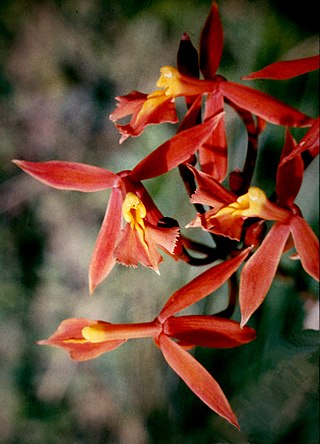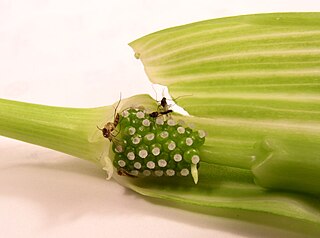
Orchids are plants that belong to the family Orchidaceae, a diverse and widespread group of flowering plants with blooms that are often colourful and fragrant. Orchids are cosmopolitan plants that are found in almost every habitat on Earth except glaciers. The world's richest diversity of orchid genera and species is found in the tropics.

A pollinator is an animal that moves pollen from the male anther of a flower to the female stigma of a flower. This helps to bring about fertilization of the ovules in the flower by the male gametes from the pollen grains.

The stamen is the pollen-producing reproductive organ of a flower. Collectively, the stamens form the androecium.

The column, or technically the gynostemium, is a reproductive structure that can be found in several plant families: Aristolochiaceae, Orchidaceae, and Stylidiaceae.

Pollination is the transfer of pollen from an anther of a plant to the stigma of a plant, later enabling fertilisation and the production of seeds. Pollinating agents can be animals such as insects, for example beetles or butterflies; birds, and bats; water; wind; and even plants themselves. Pollinating animals travel from plant to plant carrying pollen on their bodies in a vital interaction that allows the transfer of genetic material critical to the reproductive system of most flowering plants. When self-pollination occurs within a closed flower. Pollination often occurs within a species. When pollination occurs between species, it can produce hybrid offspring in nature and in plant breeding work.

Asclepias is a genus of herbaceous, perennial, flowering plants known as milkweeds, named for their latex, a milky substance containing cardiac glycosides termed cardenolides, exuded where cells are damaged. Most species are toxic to humans and many other species, primarily due to the presence of cardenolides. However, as with many such plants, some species feed upon them or from them. The most notable of them is the monarch butterfly, which uses and requires certain milkweeds as host plants for their larvae.

Pseudocopulation describes behaviors similar to copulation that serve a reproductive function for one or both participants but do not involve actual sexual union between the individuals. It is most generally applied to a pollinator attempting to copulate with a flower. Some flowers mimic a potential female mate visually, but the key stimuli are often chemical and tactile. This form of mimicry in plants is called Pouyannian mimicry.

Phalaenopsis, also known as moth orchids, is a genus of about seventy species of plants in the family Orchidaceae. Orchids in this genus are monopodial epiphytes or lithophytes with long, coarse roots, short, leafy stems and long-lasting, flat flowers arranged in a flowering stem that often branches near the end. Orchids in this genus are native to India, Taiwan, China, Southeast Asia, New Guinea and Australia with the majority in Indonesia and the Philippines.

Epidendroideae is a subfamily of plants in the orchid family, Orchidaceae. Epidendroideae is larger than all the other orchid subfamilies together, comprising more than 15,000 species in 576 genera. Most epidendroid orchids are tropical epiphytes, typically with pseudobulbs. There are, however, some terrestrials such as Epipactis and even a few myco-heterotrophs, which are parasitic upon mycorrhizal fungi.

Buzz pollination or sonication is a technique used by some bees, such as solitary bees, to release pollen which is more or less firmly held by the anthers. The anthers of buzz-pollinated plant species are typically tubular, with an opening at only one end, and the pollen inside is smooth-grained and firmly attached. With self-fertile plants such as tomatoes, wind may be sufficient to shake loose the pollen through pores in the anther and accomplish pollination. Visits by bees may also shake loose some pollen, but more efficient pollination of those plants is accomplished by a few insect species who specialize in sonication or buzz pollination.

The tribe Euglossini, in the subfamily Apinae, commonly known as orchid bees or euglossine bees, are the only group of corbiculate bees whose non-parasitic members do not all possess eusocial behavior.

Calotropis is a genus of flowering plants in the family Apocynaceae, first described as a genus in 1810. It is native to southern Asia and North Africa.

Chiloglottis, commonly known as wasp orchids, ant orchids or bird orchids, is a genus of about 25 species of flowering plants in the orchid family, Orchidaceae and is found in eastern Australia and New Zealand. Wasp orchids are terrestrial herbs which grow in colonies of genetically identical plants. They usually have two leaves at the base of the plant and a single resupinate ("upside-down") flower. The labellum is more or less diamond-shaped and has calli resembling the body of a wingless female wasp.

Coryanthes, commonly known as bucket orchids, is a genus of neotropical epiphytic orchids. This genus is abbreviated as Crths in horticultural trade. They are native to South America, Central America, Mexico and Trinidad.

Cephalanthera longifolia, the narrow-leaved helleborine, sword-leaved helleborine or long-leaved helleborine, is a rhizomatous herbaceous perennial plant in the family Orchidaceae. It is native to light woodland, and widespread across Europe, Asia and North Africa from Ireland and Morocco to China. This includes the United Kingdom, Iran, Russia, Kazakhstan, Turkey, Algeria, India, Pakistan, Germany, Italy, France, Spain, Portugal and many other countries.

Asclepias asperula, commonly called antelope horns milkweed or spider milkweed, is a species of milkweed native to the Southwestern United States and northern Mexico.

Asclepias meadii is a rare species of milkweed known by the common name Mead's milkweed. It is native to the American Midwest, where it was probably once quite widespread in the tallgrass prairie. Today much of the Midwest has been fragmented and claimed for agriculture, and the remaining prairie habitat is degraded.

Pollination traps or trap-flowers are plant flower structures that aid the trapping of insects, mainly flies, so as to enhance their effectiveness in pollination. The structures of pollination traps can include deep tubular corollas with downward pointing hairs, slippery surfaces, adhesive liquid, attractants, flower closing and other mechanisms.

The pollination of orchids is a complex chapter in the biology of this family of plants that are distinguished by the complexity of their flowers and by intricate ecological interactions with their pollinator agents. It has captured the attention of numerous scientists over time, including Charles Darwin, father of the theory of evolution by natural selection. Darwin published in 1862 the first observations of the fundamental role of insects in orchid pollination, in his book The Fertilization of Orchids. Darwin stated that the varied stratagems orchids use to attract their pollinators transcend the imagination of any human being.

Ceropegia ampliata is a flowering plant in the dogbane family Apocynaceae, native to eastern and southern Africa, including Kenya, Tanzania, Mozambique, South Africa, Eswatini, Botswana, and Madagascar. Common names include bushman's pipe, condom plant, and horny wonder.



























